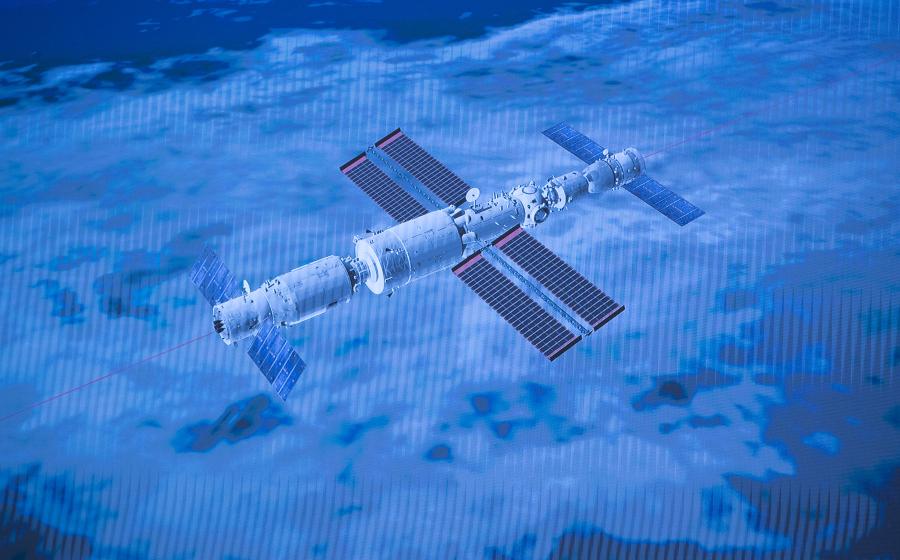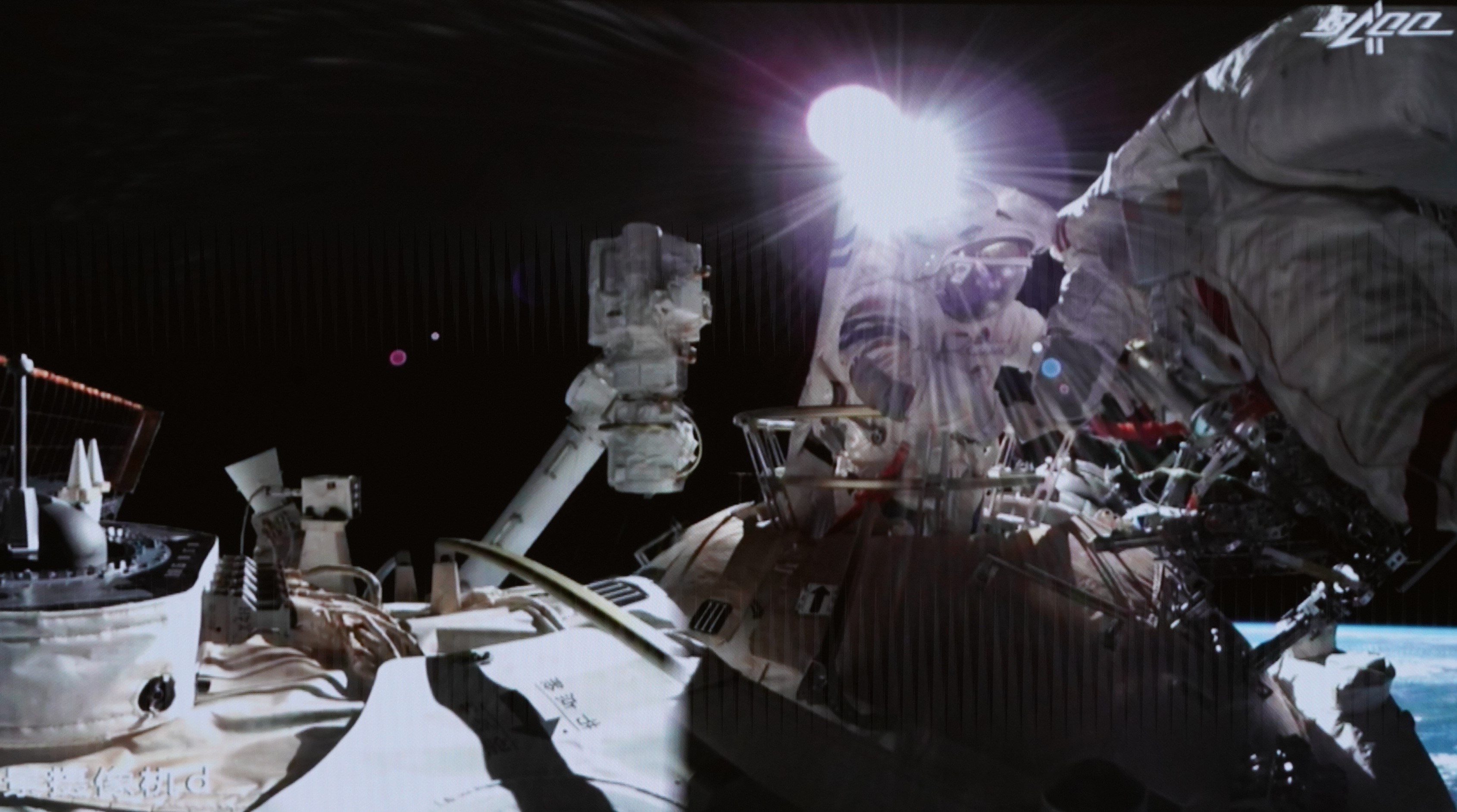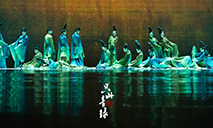New extravehicular pump ensures stable operation of China's space station

Screen image taken at Beijing Aerospace Control Center on Aug. 20, 2021 shows Chinese astronauts Nie Haisheng and Liu Boming waving their hands after conducting extravehicular activities (EVAs) out of the space station core module Tianhe.(Xinhua/Tian Dingyu)
BEIJING, Aug. 25 (Xinhua) -- Chinese astronauts Nie Haisheng and Liu Boming completed extravehicular activities (EVAs) for the second time during the construction of the space station on Aug. 20. They installed extravehicular extended pump sets and lifted the panoramic camera in their EVAs.
The newly installed extravehicular extended pump sets will play a key role in ensuring the in-orbit operation of China's space station for no less than 15 years, according to the China Academy of Space Technology (CAST).

Screen image captured at Beijing Aerospace Control Center in Beijing, capital of China, June 17, 2021 shows China's Shenzhou-12 manned spaceship having successfully docked with the space station core module Tianhe. (Xinhua/Jin Liwang)
EXTRAVEHICULAR "HEART"
Developed by the CAST, the extended pump sets are called the "heart" of the fluid loop, which is a core part of the space station's thermal control system.
"Like a heart providing power for blood flow and sending blood to all parts of a body, the pump sets keep the special liquid circulating stably in the loop," said Han Haiying, a CAST designer of the thermal control system.
Without the protection of the atmosphere, the surface temperature of the space station can reach more than 150 degrees Celsius under the sunlight. While in the dark, its surface temperature can drop to lower than minus 100 degrees Celsius.
In this harsh space environment, the thermal control system is crucial in ensuring the normal operation of the space station's equipment and comfortable living conditions for the astronauts.
The fluid loop evenly covers the key parts of the space station. By circulating the special liquid in the loop, it is capable of collecting heat generated by onboard equipment and astronauts for cooling and bring the heat to relevant devices and structures for heat supplementation, according to Zheng Hongyang, a CAST engineer in charge of the fluid loop of the thermal control system.
It can also help precisely control the temperatures of various "rooms" in the space station, said Zheng.
"Always operating at a high speed, the liquid loop pumps have a limited service life and must be repairable and replaceable," Han said.
The thermal control team thus created multiple "hearts" for both inside and outside the cabin for the fluid loop, so as to empower the system with ultra-long operation capability.

Screen image taken at Beijing Aerospace Control Center on Aug. 20, 2021 shows Chinese astronauts Nie Haisheng and Liu Boming conducting extravehicular activities (EVAs) out of the space station core module Tianhe. (Xinhua/Tian Dingyu)
SIMPLE BUT IMPORTANT MOVE
In the space environment, astronauts wearing spacesuits are restricted in their movements. A simple action, such as turning a screw, could cost them a lot of energy and time.
The CAST team did their best to simplify the procedure of installing the extended pump sets, making it a four-step process.
The astronauts need to hook and lock the pump sets to the outer wall of the space station core module Tianhe, and then connect the electric circuit as well as the liquid circuit.

Screen image captured at Beijing Aerospace Control Center in Beijing, capital of China, June 17, 2021 shows three Chinese astronauts onboard the Shenzhou-12 spaceship saluting after entering the space station core module Tianhe. (Xinhua/Jin Liwang)
The newly completed EVAs not only verified the technology of installing pump sets in orbit but also laid a good foundation for the following construction of the space station and stable operation of the station for up to 15 years, according to the CAST.
The three Chinese astronauts were sent into space onboard the Shenzhou-12 spaceship and entered Tianhe on June 17. Astronauts Liu Boming and Tang Hongbo completed the first EVAs on July 4.
The Shenzhou-12 spaceship crew will continue to carry out scientific and technological space experiments before their planned return in the middle of September.
Photos
 Dance show saluting traditional culture of the Song Dynasty makes its debut
Dance show saluting traditional culture of the Song Dynasty makes its debut Village in SW China’s Yunnan embraces prosperity through agricultural tourism
Village in SW China’s Yunnan embraces prosperity through agricultural tourism Eighth birthday for pair of giant pandas celebrated in Haikou, Hainan province
Eighth birthday for pair of giant pandas celebrated in Haikou, Hainan province Olympic gold medalists portrayed in Shanxi artist’s polymer clay sculptures
Olympic gold medalists portrayed in Shanxi artist’s polymer clay sculptures
Related Stories
- Chinese astronauts complete second time EVAs for space station construction
- How Chinese astronauts stay healthy in space
- Providing water for China's space station astronauts
- Model of China's space station core module Tianhe in Shanghai Astronomy Museum
- China’s space station recycles 66 liters of urine in 3 weeks to support crew
Copyright © 2021 People's Daily Online. All Rights Reserved.






